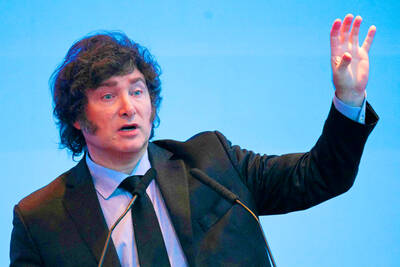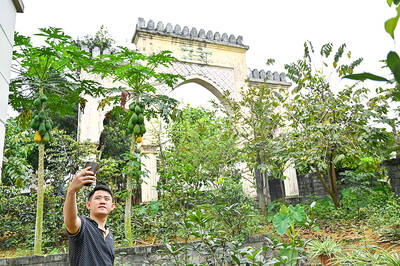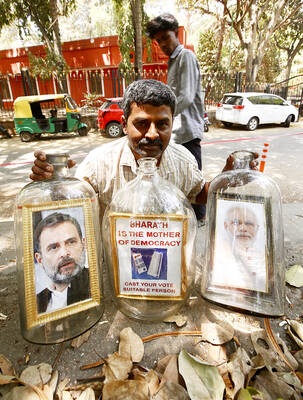Poland yesterday marked 80 years since the Warsaw Ghetto Uprising, when hundreds of Jews launched a doomed attack against the Nazis, with the commemorations looking beyond the fighters and emphasizing the civilian experience.
The presidents of Germany and Israel were scheduled to join their Polish counterpart for the anniversary of the month-long revolt, which was the largest single act of Jewish resistance against the Germans during World War II.
Church bells and sirens were to sound at midday in honor of the insurgents who launched the uprising on April 19, 1943, and who died fighting rather than in gas chambers.

Photo: EPA-EFE
The heads of state were to speak at the Warsaw Ghetto memorial at the heart of the former Jewish district, before heading to a synagogue together.
As in previous years, volunteers across the city were to hand out paper daffodils for residents to pin to their jackets. The tradition is in honor of Marek Edelman, an uprising commander who, until his death in 2009, would mark the anniversary by depositing a bouquet of the flowers at the memorial.
Because of their color and form, daffodils resemble the yellow stars Nazis forced Jews to wear.
This year, the paper daffodils were also to be distributed in other Polish cities.
“We hope to hand out a total of 450,000 paper flowers,” said Zofia Bojanczyk, coordinator of the daffodil initiative.
“The figure symbolizes the number of Jewish women and men confined to the Warsaw Ghetto when it was at its most crowded,” she told reporters.
One year after they invaded Poland in 1939, the Germans set up the ghetto in a space of just more than 3km2. It was the largest of the World War II ghettos.
Many Jews died inside of starvation and disease, while most of the rest were sent to the Treblinka death camp.
At the outbreak of the uprising, about 50,000 civilians were still hiding in cellars and bunkers in the ghetto. The Germans put down the uprising with extreme brutality and set fire to the entire district, turning it to rubble and ash.
A number of events are being held for the anniversary, including talks by survivors, concerts, film screenings and theater performances.
The Kordegarda gallery has an exhibition of everyday items from the ghetto, which were recently unearthed and tell the story of how Jews in wartime Warsaw lived, loved and died.
“These are, so to speak, voices from the buried city, calling from beneath our feet,” cocurator Jacek Konik said.
A separate show, at the Polin Museum of the History of Polish Jews, features never-before-seen photographs of the ghetto taken by a Polish firefighter. They offer a different perspective, as until now most images of the ghetto were taken by Nazis.

As the sun sets on another scorching Yangon day, the hot and bothered descend on the Myanmar city’s parks, the coolest place to spend an evening during yet another power blackout. A wave of exceptionally hot weather has blasted Southeast Asia this week, sending the mercury to 45°C and prompting thousands of schools to suspend in-person classes. Even before the chaos and conflict unleashed by the military’s 2021 coup, Myanmar’s creaky and outdated electricity grid struggled to keep fans whirling and air conditioners humming during the hot season. Now, infrastructure attacks and dwindling offshore gas reserves mean those who cannot afford expensive diesel

Does Argentine President Javier Milei communicate with a ghost dog whose death he refuses to accept? Forced to respond to questions about his mental health, the president’s office has lashed out at “disrespectful” speculation. Twice this week, presidential spokesman Manuel Adorni was asked about Milei’s English Mastiff, Conan, said to have died seven years ago. Milei, 53, had Conan cloned, and today is believed to own four copies he refers to as “four-legged children.” Or is it five? In an interview with CNN this month, Milei referred to his five dogs, whose faces and names he had engraved on the presidential baton. Conan,

Le Tuan Binh keeps his Moroccan soldier father’s tombstone at his village home north of Hanoi, a treasured reminder of a man whose community in Vietnam has been largely forgotten. Mzid Ben Ali, or “Mohammed” as Binh calls him, was one of tens of thousands of North Africans who served in the French army as it battled to maintain its colonial rule of Indochina. He fought for France against the Viet Minh independence movement in the 1950s, before leaving the military — as either a defector or a captive — and making a life for himself in Vietnam. “It’s very emotional for me,”

Indian Prime Minister Narendra Modi reaffirmed his pledge to replace India’s religion-based marriage and inheritance laws with a uniform civil code if he returns to office for a third term, a move that some minority groups have opposed. In an interview with the Times of India listing his agenda, Modi said his government would push for making the code a reality. “It is clear that separate laws for communities are detrimental to the health of society,” he said in the interview published yesterday. “We cannot be a nation where one community is progressing with the support of the Constitution while the other